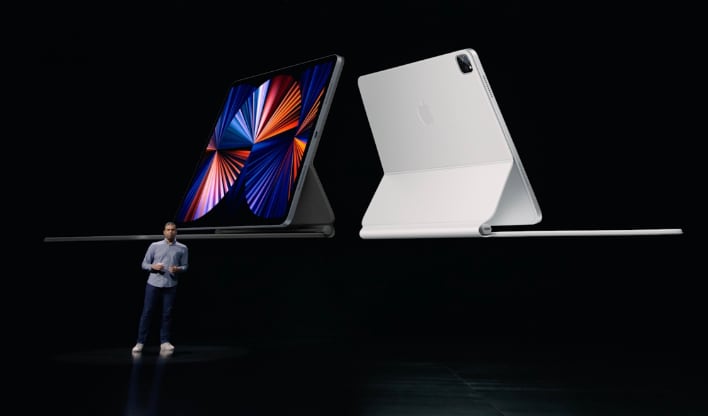Here's Why M1 iPad Pro Owners Are Complaining Of Ugly And Distracting XDR Display Blooming
Apple has mightily boasted about the Liquid Retina XDR display, which features over 10,000 Mini LEDs grouped into 2,596 local dimming zones. This gives the display a 1,000:000:1 aspect ratio, with sustained brightness of 1,000 nits and a maximum brightness of 1,600 nits.

However, that same Liquid Retina XDR display is causing some significant viewing issues for some users regarding "blooming." Blooming is when the LED-backlit dimming zones behind an on-screen object bleed beyond its boundaries. This makes objects look like they have a halo around them, which appears rather odd and quite off-putting for a device that costs $1,099 in its cheapest form.
Here’s my experience with the blooming on the M1 #iPadPro so far. It’s very noticeable in dark room with UI elements on top of a black background, but that’s the only scenario where I really notice it. It’s expected with this display tech but still jarring coming from OLED. pic.twitter.com/8tG1euFzqn
— Josh Teder (@JoshTeder) May 22, 2021
This is how Apple describes the display and blooming effects in a support document:
The Liquid Retina XDR display improves upon the trade-offs of typical local dimming systems, where the extreme brightness of LEDs might cause a slight blooming effect because the LED zones are larger than the LCD pixel size. This display is designed to deliver crisp front-of-screen performance with its incredibly small custom mini-LED design, industry leading mini-LED density, large number of individually controlled local dimming zones, and custom optical films that shape the light while maintaining image fidelity and extreme brightness and contrast.
When looking at a screen with a black background, you will see inky blacks (like OLEDs) accompanied by unsightly blooming artifacts around objects. This is different from traditional LED-backlit displays, in which a primarily black background will look almost grey-ish with minimal to no blooming.
Hearing alot about the halo effect in the new 12.9" miniLED iPad Pro. Here it is explained from our MiniLED Report. So even 1M:1 contrast ratio displays can get it. Need more dimming zones. Not a problem for OLEDs though. pic.twitter.com/Zin0nE4tmr
— Ross Young (@DSCCRoss) May 25, 2021
Ross Young, an analyst for Ross Young, took to Twitter to visualize the perceived differences between what blooming looks like on a traditional LCD panel versus Mini LED.
OLED panels don't have a problem with blooming due to per-pixel lighting control. Still, you have to contend with pixel longevity, potential burn-in, and the fact that OLEDs can't get as bright as a comparable Mini LED panel.
What can happen when you have 2,500 dimming zones. This is noticeable when you use iPad Pro 2021 in total darkness.
— Parka (@ParkaBlogs) May 21, 2021
iPad Pro 2018 has less distracting blooming because the bloom covers a large area. And there's IPS glow.
More on this tomorrow https://t.co/yGqFwdeJwz pic.twitter.com/7q82vAvc5d
"The miniLED iPad Pro has 2596 zones so each zone controls around 2155 pixels. In an OLED version, there is pixel level control, so each pixel is its own zone or nearly 5.6M zones/pixels," said Young. "But will you see a difference? No halo effect so that is an advantage for OLED. But the miniLED is brighter."
It remains to be seen if Apple will be able to minimize the effect of blooming with the 12.9-inch iPad Pro's Liquid Retina XDR display with future software updates, but it's something to keep in mind if the tablet was on your wish list.

